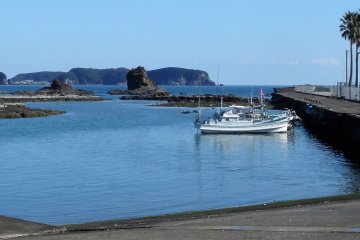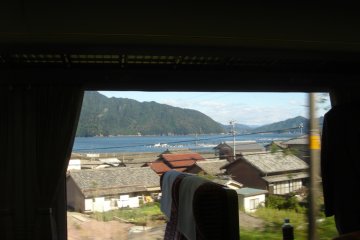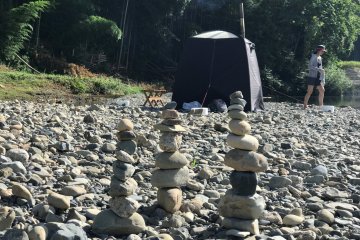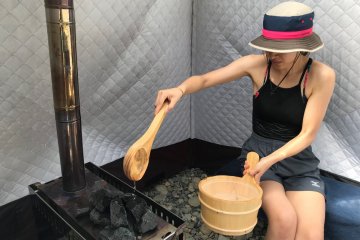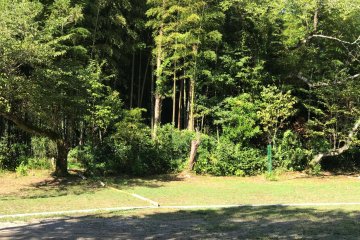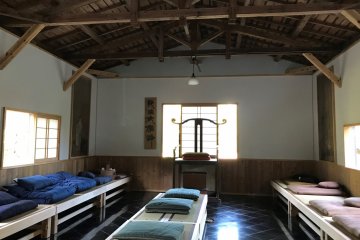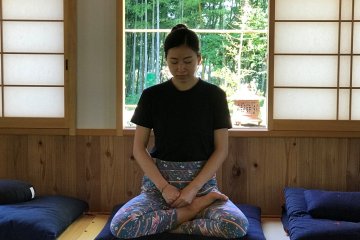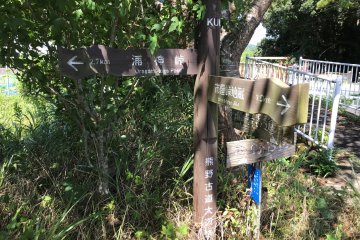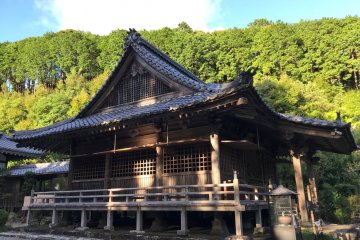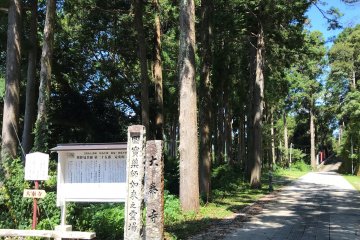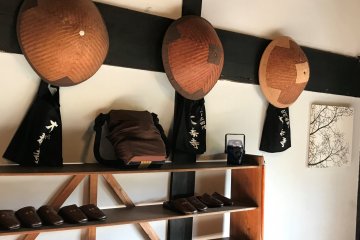How does a hot session in a sauna tent followed by a cold dip in the nearby stream combine with morning prayers at a temple and a meditation session at a Zazen dojo?
If you love nature and the Great Outdoors and you equally love visiting temples and engaging in mindfulness practices, then this is the perfect place for you to spend a weekend. And now you can do so in a camper van or a tent at the temple's very own campsite!
Although I have been living in the Kumano area of Wakayama Prefecture south on the Kii-Peninsula for ten years now, I had never heard about Daitai-ji temple in Nachi-Katsuura Town until recently. A friend suggested a weekend away together, and she wanted to go to this “temple hotel”. I was a bit skeptical but I am always up for a surprise and so I went along.
On our drive to Daitai-ji we passed by all of Nachi-Katsuura’s attractions and went straight to the temple where the temple’s abbot, Mr. Nishiyama, greeted us and bid us a friendly welcome. Then he handed us over to his “assistant”, a woofer who helped out at the temple during the summer. We walked through a bamboo grove straight to the river at the base of the hill on which Daitai-ji is located.. This was the location for our first “temple adventure”.



Hot and Cold: Sauna Tent and River Dip
For the next two hours we had a sauna tent propped up on the shores of a shallow river all to ourselves. My friend and I popped our heads into the tent to check out the temperature and we almost scourges our faces. It was freaking hot! Just what one should expect from a sauna.
The heat came from a wood-fired stove set up in the middle of the tent. Behind the stove was a bench to sit down on for as long as we could stand the dry heat. Next to the stove was a wooden basket with a ladle to scope out water and to put it on some hot stones that had been placed on top of the stove. This way we could increase the heat and add some moisture to the air.
Now, this is not your regular temple activity but a new trend that is inspired by combing nature with spirituality and thereby make a temple stay more suitable for nature lovers and make it more appealing to a younger crowd.
If you are familiar with sauna tents in Europe, you might be worried that you have to strip and go nude. Not so here in Japan! Users of this sauna wear swimming costumes which you can put on in a room at the temple. Wearing a swimming costume is also a good preparation for the cold dip in the river that follows the sauna experience. Since the river is a public place, bathing unclothed would not be appropriate.
The river is very shallow so that you have to lie down in order to be fully covered by water. This is also a good way to let the current carry you for a short while. Just float in the stream and cool down.
There are some camping chairs set up next to the river that you can sit in for a while before heading back into the sauna tent. This way you can spend a couple of hours easily.
In summer you might not want to go into a sauna tent and in the cooler season you probably do not want to jump into a river, yet the combination of hot and cold creates a balance that makes this activity suitable year-round.



Private Guided Zen Meditation
The Abbot of Daitai-ji, Mr. Nishiyama, has spent several years travelling in Southeast Asia. He speaks good English and he is familiar with the wants and needs of foreigners. He will guide you through a Zazen session at the newly created Zen meditation hall of the temple.
Many foreigners face the problem that they cannot sit cross-legged for a long time. Mr. Nishiyama explains that this so-called "Lotus-style" way of sitting was comfortable for people in the old days. At the time people were smaller in size. They had a short body and short legs and sitting cross-legged felt comfortable for them. Not so for us now! This is why at Daitai-ji it is possible to sit comfortably on a bench when doing Zazen.
Daitai-ji belongs to the Rinzai sect of Zen Buddhism as compared to the Soto sect. There is a distinct difference in the way that both sects conduct their Zazen meditation session. While Soto practitioners sit facing a wall, the Rinzai practitioners sit facing out.
This doesn't mean that you should secretly observe the person sitting opposite you! You are meant to direct your gaze towards the ground about 1 meter in front of you and try to keep your eyes half open, half closed. Don't close your eyes, or else you might fall asleep.
If you sit cross-legged, then your legs and your body should make a triangle shape to have a stable posture. A straight spine, chin tugged in, relaxed shoulders, and arms resting on your knees with your hands forming a kind of O-shape, this is the way you sit for 15 minutes at the time.
The whole set is 1 hour, which contains 15 minutes of explanation followed by 15 minutes of sitting, times two.
The Zazen hall is airy and light-filled featuring big windows and a large door that is kept open during the warm season. You might just forget your worries for a short while and have a Zen moment listening to the chirping of the birds outside or sensing a falling leave floating through the air.


Pitch a tent
On a meadow next to the Zazen hall of the temple you can park your camper van or pitch your tent. Yes, you heard right! This is possible right here at the temple because Daitai-ji is the first campsite in Japan that is registered at a temple!
There is space for 5 camper vans or cars and for 4 tents. Each camper van plot is equipped with an electrical outlet and there are the usual campsite facilities like bathrooms and fire pits. Reservations are for one night at the time. Alternatively, you can book to sleep in Daitai-ji's "temple hotel". The historic temple accommodation is available for rent, max. two parties at the time.
In the morning you wake up to the ringing of the temple bell and Buddhist chanting to get you in the right mood for some temple experiences, such as Zazen meditation or sutra copying. These activities require an advanced booking and there is a fee in addition to the accommodation free. f you would like to know more about the temple's Buddhist statues, then ask the temple's abbot for guided tour, which is free.


Kumano Kodo Hiking or Biking
For the active travelers the Kumano Kodo pilgrimage trail beckons to be explored. The trail passes by right by the temple gate.
Most hikers skip this part of the Kumano Kodo as they finish their hike along the Nakahechi route in Nachi-Katsuura. However, if you would like to walk a stretch on what is called the Ohechi route of the Kumano Kodo, which follows the coast around the tip of the Kii Peninsula from Nachi-Katsuura to Tonda near Tanabe, then you can walk from Daitai-ji.
The temple is located on the 15 km stretch of the trail that connects Nachi Station with Kii-Uragami Station on the local JR Line. It takes about 5 to 6 hours to walk this distance.
The Kii-Peninsula is also a great location for riding a bicycle and cycle around the tip of the peninsula following the coast line. There are some well developed southern Wakayama cycling courses. Ocean views on one side and mountain views on the other side! Part of the Kumano Kodo trail now follows a road. So, you can do the Kumano Kodo pilgrimage on bicycle!

Workcation and Company Retreat
Even better, you can bring your laptop and your colleagues!
The temple facilities are available for day-use so that you can plan a day retreat, talk or conference there.
Daitai-ji is an ideal workcation place fully equipped with fast WiFi and power supply, even at the campsite!
Why not stay with a group of colleagues and get some work done before hitting the road and visiting some of Wakayama's spectacular natural places and the nearby UNESCO Heritage Sites in Nachi, Shingu and Hongu.




